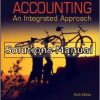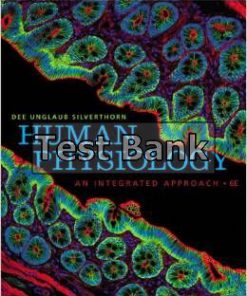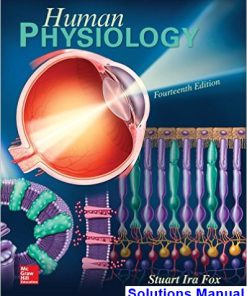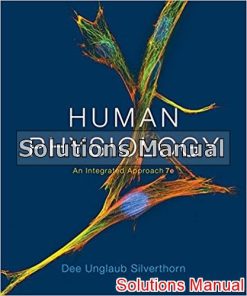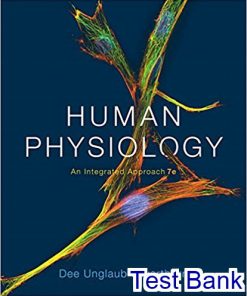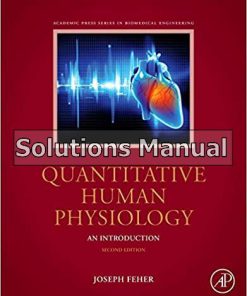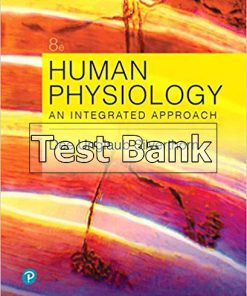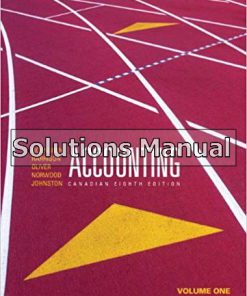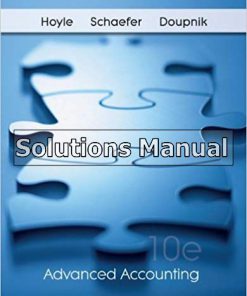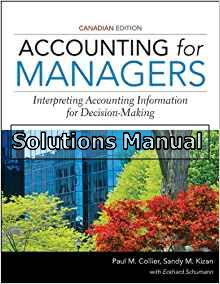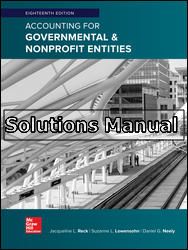Quantitative Human Physiology An Introduction 1st Edition Feher Solutions Manual
$50.00 Original price was: $50.00.$26.50Current price is: $26.50.
Quantitative Human Physiology An Introduction 1st Edition Feher Solutions Manual.
This is completed downloadable of Quantitative Human Physiology An Introduction 1st Edition Feher Solutions Manual
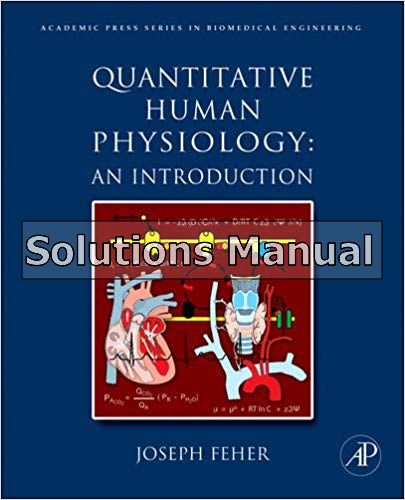
Product Details:
- ISBN-10 : 0123821630
- ISBN-13 : 978-0123821638
- Author: Joseph J Feher Ph.D. Cornell University (Author)
Quantitative Human Physiology: An Introduction presents a course in quantitative physiology developed for undergraduate students of Biomedical Engineering at Virginia Commonwealth University. The text covers all the elements of physiology in nine units: (1) physical and chemical foundations; (2) cell physiology; (3) excitable tissue physiology; (4) neurophysiology; (5) cardiovascular physiology; (6) respiratory physiology; (7) renal physiology; (8) gastrointestinal physiology; and (9) endocrinology. The text makes extensive use of mathematics at the level of calculus and elementary differential equations. Examples and problem sets are provided to facilitate quantitative and analytic understanding, while the clinical applications scattered throughout the text illustrate the rationale behind the topics discussed. This text is written for students with no knowledge of physiology but with a solid background in calculus with elementary differential equations. The text is also useful for instructors with less time; each chapter is intended to be a single lecture and can be read in a single sitting.
Table of Content:
UNIT 1. Physical and Chemical Foundations of Physiology
1.1. The Core Principles of Physiology
Human Physiology Is the Integrated Study of the Normal Function of the Human Body
Cells Are the Organizational Unit of Life
The Concept of Homeostasis Is a Central Theme of Physiology
The Body Consists of Causal Mechanisms That Obey the Laws of Physics and Chemistry
Evolution Is an Efficient Cause of the Human Body Working Over Long Time Scales
Living Beings Transform Energy and Matter
Function Follows Form
Coordinated Command and Control Requires Signaling at All Levels of Organization
Physiology Is a Quantitative Science
Summary
Review Questions
1.2. Physical Foundations of Physiology I
Forces Produce Flows
Conservation of Matter or Energy Leads to the Continuity Equation
Steady-State Flows Require Linear Gradients
Heat, Charge, Solute, and Volume Can Be Stored: Analogues of Capacitance
Pressure Drives Fluid Flow
Poiseuille’s Law Governs Steady-State Laminar Flow in Narrow Tubes
The Law of LaPlace Relates Pressure to Tension in Hollow Organs
Summary
Review Questions
Appendix 1.2.A1 Derivation of Poiseuille’s Law
1.3. Physical Foundations of Physiology II
Coulomb’s Law Describes Electrical Forces
The Electric Potential Is the Work per Unit Charge
The Idea of Potential Is Limited to Conservative Forces
Potential Difference Depends Only on the Initial and Final States
The Electric Field Is the Negative Gradient of the Potential
Force and Energy Are Simple Consequences of Potential
Gauss’s Law Is a Consequence of Coulomb’s Law
The Capacitance of a Parallel Plate Capacitor Depends on its Area and Plate Separation
Biological Membranes Are Electrical Capacitors
Electric Charges Move in Response to Electric Forces
Movement of Ions in Response to Electrical Forces Make a Current and a Solute Flux
The Relation Between J and C Defines an Average Velocity
Summary
Review Questions
Problem Set 1.1. Physical Foundations
1.4. Chemical Foundations of Physiology I
Atoms Contain Distributed Electrical Charges
Electron Orbitals Have Specific, Quantized Energies
Human Life Requires Relatively Few of the Chemical Elements
Atomic Orbitals Explain the Periodicity of Chemical Reactivities
Atoms Bind Together in Definite Proportions to Form Molecules
Compounds Have Characteristic Geometries and Surfaces
Single CC Bonds Can Freely Rotate
Double CC Bonds Prohibit Free Rotation
Chemical Bonds Have Bond Energies, Bond Lengths, and Bond Angles
Bond Energy Is Expressed as Enthalpy Changes
The Multiplicity of CX Bonds Produces Isomerism
Unequal Sharing Makes Polar Covalent Bonds
Water Provides an Example of a Polar Bond
Intermolecular Forces Arise from Electrostatic Interactions
Atoms Within Molecules Wiggle and Jiggle and Bonds Stretch and Bend
Summary
Review Questions
Appendix 1.4.A1 Dipole Moment
1.5. Chemical Foundations of Physiology II
Avogadro’s number Counts the Particles in a Mole
Concentration is the Amount per unit Volume
Scientific Prefixes Indicate Order of Magnitude
Dilution of Solutions Is Calculated Using Conservation of Solute
Calculation of Fluid Volumes By the Fick Dilution Principle
Chemical Reactions Have Forward and Reverse Rate Constants
The Michaelis–Menten Formulation of Enzyme Kinetics
Summary
Review Questions
Appendix 1.5.A1 Transition State Theory Explains Reaction Rates in Terms of An Activation Energy
The Activation Energy Depends on the Path
1.6. Diffusion
Fick’s First Law of Diffusion Was Proposed in Analogy to Fourier’s Law of Heat Transfer
Fick’s Second Law of Diffusion Follows from the Continuity Equation and Fick’s First Law
Fick’s Second Law Can Be Derived from the One-Dimensional Random Walk
The Time for One-Dimensional Diffusion Increases with the Square of Distance
Diffusion Coefficients in Cells Are Less than the Free Diffusion Coefficient in Water
External Forces Can Move Particles and Alter the Diffusive Flux
The Stokes–Einstein Equation Relates the Diffusion Coefficient to Molecular Size
Summary
Review Questions
1.7. Electrochemical Potential and Free Energy
Diffusive and Electrical Forces Can Be Unified in the Electrochemical Potential
The Overall Force That Drives Flux Is the Negative Gradient of the Electrochemical Potential
The Electrochemical Potential Is the Gibbs Free Energy Per Mole
The Sign of ΔG Determines the Direction of a Reaction
Processes with ΔG>0 Can Proceed Only by Linking Them with Another Process with ΔG<0
The Large Negative Free Energy of ATP Hydrolysis Powers Many Biological Processes
Measurement of the Equilibrium Concentrations of ADP, ATP, and Pi Allows Us to Calculate ΔG0
Summary
Review Questions
Problem Set 1.2. Kinetics and Diffusion
UNIT 2. Membranes, Transport, and Metabolism
2.1. Cell Structure
For Cells, Form Follows Function
Organelles Make Up the Cell Like the Organs Make Up the Body
The Cell Membrane Marks the Limits of the Cell
The Cytosol Provides a Medium for Dissolution and Transport of Materials
The Cytoskeleton Supports the Cell and Forms a Network for Vesicular Transport
The Nucleus Is the Command Center of the Cell
Ribosomes Are the Site of Protein Synthesis
The ER Is the Site of Protein and Lipid Synthesis and Processing
The Golgi Apparatus Packages Secretory Materials
The Mitochondrion Is the Powerhouse of the Cell
Lysosomes and Peroxisomes Are Bags of Enzymes
Proteasomes Degrade Marked Proteins
Cells Attach to Each Other Through a Variety of Junctions
Summary
Review Questions
Appendix 2.1.A1 Some Methods for Studying Cell Structure and Function
2.2. DNA and Protein Synthesis
DNA Makes Up the Genome
DNA Consists of Two Intertwined Sequences of Nucleotides
RNA Is Closely Related to DNA
Messenger RNA Carries the Instructions for Making Proteins
Ribosomal RNA Is Assembled in the Nucleolus from a DNA Template
Transfer RNA Covalently Binds Amino Acids and Recognizes Specific Regions of mRNA
The Genetic Code Is a System Property
Regulation of DNA Transcription Defines the Cell Type
The Histone Code Provides Another Level of Regulation of Gene Transcription
Summary
Review Questions
2.3. Protein Structure
Amino Acids Make Up Proteins
Hydrophobic Interactions Can Be Assessed from the Partition Coefficient
Peptide Bonds Link Amino Acids Together in Proteins
Protein Function Centers on Their Ability to Form Reactive Surfaces
There Are Four Levels of Description for Protein Structure
Posttranslational Modification Regulates and Refines Protein Structure and Function
Protein Activity Is Regulated by the Number of Molecules or by Reversible Activation/Inactivation
Summary
Review Questions
2.4. Biological Membranes
Biological Membranes Surround Most Intracellular Organelles
Biological Membranes Consist of a Lipid Bilayer Core with Embedded Proteins and Carbohydrate Coats
Organic Solvents Can Extract Lipids from Membranes
Biological Membranes Contain Mostly Phospholipids
Phospholipids Contain Fatty Acyl Chains, Glycerol, Phosphate, and a Hydrophilic Group
Other Lipid Components of Membranes Include Cardiolipin, Sphingolipids, and Cholesterol
Phospholipids in Water Self-Organize into Layered Structures
Surface Tension of Water Results from Asymmetric Forces at the Interface
Amphipathic Molecules Spread Over a Water Surface, Reduce Surface Tension, and Produce an Apparent Surface Pressure
Phospholipids Form Bilayer Membranes Between Two Aqueous Compartments
Lipid Bilayers Can Also Form Liposomes
Lipids Maintain Dynamic Motion within the Bilayer
Lipid Rafts Are Special Areas of Lipid and Protein Composition
Membrane Proteins Bind to Membranes with Varying Affinity
Secreted Proteins Have Special Mechanisms for Getting Inside the Endoplasmic Reticulum
Summary
Review Questions
Problem Set 2.1. Surface Tension, Membrane Structure, Microscopic Resolution, and Cell Fractionation
2.5. Passive Transport and Facilitated Diffusion
Membranes Possess a Variety of Transport Mechanisms
A Microporous Membrane Is One Model of a Passive Transport Mechanism
Dissolution in the Lipid Bilayer Is Another Model for Passive Transport
Facilitated Diffusion Uses a Membrane-Bound Carrier
Facilitated Diffusion Saturates with Increasing Solute Concentrations
Facilitated Diffusion Shows Specificity
Facilitated Diffusion Shows Competitive Inhibition
Passive Transport Occurs Spontaneously Without Input of Energy
Ions Can be Passively Transported Across Membranes by Ionophores or by Channels
Water Moves Passively Through Aquaporins
Summary
Review Questions
2.6. Active Transport
The Electrochemical Potential Difference Measures the Energetics of Ion Permeation
Active Transport Mechanisms Link Metabolic Energy to Transport of Materials
Na,K-ATPase is an Example of Primary Active Transport
Na,K-ATPase forms a Phosphorylated Intermediate
There Are Many Different Primary Active Transport Pumps
The Na–Ca Exchanger as an Example of Secondary Active Transport
Secondary Active Transport Mechanisms Are Symports or Antiports
Summary
Review Questions
2.7. Osmosis and Osmotic Pressure
The Model for Water Transport Is a Microporous Membrane
Case A: The Solute Is Very Small Compared to the Pore
Case B: The Solute Is Larger than the Pore: Osmosis
The van’t Hoff Equation Relates Osmotic Pressure to Concentration
The Osmotic Coefficient Corrects for NonIdeal Behavior of Solutions
Osmosis in a Microporous Membrane Is Caused by a Momentum Deficit within the Pores
The Flow across a Membrane Responds to the Net Hydrostatic and Osmotic Pressure
Case C: The Solute is Smaller than the Pore but is not Tiny Compared to the Pore
Solutions May Be Hypertonic or Hypotonic
Osmosis, Osmotic Pressure, and Tonicity Are Related but Distinct Concepts
Osmotic Pressure Is a Property of Solutions Related to Other Colligative Properties
Cells Behave Like Osmometers
Cells Actively Regulate their Volume through RVDs and RVIs
Summary
Review Questions
Appendix 2.7.A.1 Thermodynamic Derivation of van’t Hoff’s Law
Appendix 2.7.A2 Mechanism of Osmosis across a Microporous Membrane
Problem Set 2.2. Membrane Transport
2.8. Cell Signaling
Signaling transduces One Event into Another
Cell-to-Cell Communication Can Also Use Direct Mechanical, Electrical, or Chemical Signals
Signals Elicit a Variety of Classes of Cellular Responses
Electrical Signals and Neurotransmitters Are Fastest; Endocrine Signals Are Slowest
Voltage-Gated Ion Channels Convey Electrical Signals
Voltage-Gated Ca2+ Channels Transduce an Electrical Signal to an Intracellular Ca2+ Signal
Ligand-Gated Ion Channels Open with Chemical Signals
Heterotrimeric G-Protein-Coupled Receptors (GPCRs) Are Versatile
There Are Four Classes of G-Proteins: Gαs, Gαi/Gαo, Gαq, and Gα12/Gα13
The Response of a Cell to a Chemical Signal Depends on the Receptor and Its Effectors
Chemical Signals Can Bind to and Directly Activate Membrane-Bound Enzymes
Many Signals Alter Gene Expression
Nuclear Receptors Alter Gene Transcription
Nuclear Receptors Recruit Histone Acetylase to Unwrap the DNA from the Histones
Nuclear Receptors Recruit Transcription Factors
Other Signaling Pathways Also Regulate Gene Expression
Summary of Signaling Mechanisms
Summary
Review Questions
2.9. ATP Production I
Take a Global View of Metabolism
Energy Production and use in the Cell is Analogous to Societal Production and use of Electrical Power
Energy Production Occurs in Three Stages: Breakdown into Units, Formation of Acetyl CoA and Complete Oxidation of Acetyl CoA
Fuel Reserves are Stored in the Body Primarily in Fat Depots and Glycogen
Glucose is a Readily Available Source of Energy
Glucose Release by the Liver is Controlled by Hormones through a Second Messenger System
The Liver Exports Glucose into the Blood Because it can Dephosphorylate Glucose-1-P
A Specific Glucose Carrier Takes Glucose up into Cells
Glycolysis is a Series of Biochemical Transformations Leading from Glucose to Pyruvate
Glycolysis Generates ATP Quickly in the Absence of Oxygen
Glycolysis Requires NAD+
Gluconeogenesis Requires Reversal of Glycolysis
Summary
Review Questions
2.10. ATP Production II
Oxidation of Pyruvate Occurs in the Mitochondria via the TCA Cycle
Pyruvate Enters the Mitochondria and Is Converted to Acetyl CoA
Pyruvate Dehydrogenase Releases CO2 and Makes NADH
The TCA Cycle Is a Catalytic Cycle
The ETC Links Chemical Energy to H+ Pumping Out of the Mitochondria
Oxygen Accepts Electrons at the End of the ETC
Proton Pumping and Electron Transport Are Tightly Coupled
Oxidative Phosphorylation Couples Inward H+ Flux to ATP Synthesis
The Proton Electrochemical Gradient Provides the Energy for ATP Synthesis
NADH Forms 3 ATP Molecules; FADH2 Forms 2 ATP Molecules
ATP Can Be Produced From Cytosolic NADH
Most of the ATP Produced During Complete Glucose Oxidation Comes from Oxidative Phosphorylation
Mitochondria Have Specific Transport Mechanisms
Summary
Review Questions
2.11. ATP Production III
Fats and Proteins Contribute 60% of the Energy Content of Many Diets
Depot Fat Is Stored as Triglycerides and Broken Down to Glycerol and Fatty Acids for Energy
Glycerol Is Converted to an Intermediate of Glycolysis
Fatty Acids Are Metabolized in the Mitochondria and Peroxisomes
Beta Oxidation Cleaves Two-Carbon Pieces off Fatty Acids
The Liver Packages Substrates for Energy Production by Other Tissues
Amino Acids Can Be Used to Generate ATP
Amino Acids Are Deaminated to Enable Oxidation
Urea Is Produced During Deamination and Is Eliminated as a Waste Product
Summary
Review Questions
UNIT 3. Physiology of Excitable Cells
3.1. The Origin of the Resting Membrane Potential
Introduction
The Equilibrium Potential Arises from the Balance Between Electrical Force and Diffusion
The Equilibrium Potential for K+ Is Negative
Integration of the Nernst–Planck Electrodiffusion Equation Gives the Goldman–Hodgkin–Katz Equation
Slope Conductance and Chord Conductance Relate Ion Flows to the Net Driving Force
The Chord Conductance Equation Relates Membrane Potential to All Ion Flows
The Current Convention Is that an Outward Current Is Positive
Summary
Review Questions
Appendix 3.1.A1 Derivation of the GHK Equation
3.2. The Action Potential
Cells Use Action Potentials as Fast Signals
The Motor Neuron Has Dendrites, a Cell Body, and an Axon
Passing a Current Across the Membrane Changes the Membrane Potential
An Outward Current Hyperpolarizes the Membrane Potential
The Result of Depolarizing Stimulus of Adequate Size Is a New Phenomenon—the Action Potential
The Action Potential Is All or None
The Latency Decreases with Increasing Stimulus Strength
Threshold Is the Membrane Potential at Which an Action Potential Is Elicited 50% of the Time
The Nerve Cannot Produce a Second Excitation During the Absolute Refractory Period
The Action Potential Reverses to Positive Values, Called the Overshoot
Voltage-Dependent Changes in Ion Conductance Cause the Action Potential
Conductance Depends on the Number and State of the Channels
Patch Clamp Experiments Measure Unitary Conductances
Summary
Review Questions
Appendix 3.2.A1 The Hodgkin–Huxley Model of the Action Potential
3.3. Propagation of the Action Potential
The Action Potential Moves Along the Axon
The Velocity of Nerve Conduction Varies Directly with the Axon Diameter
The Action Potential Is Propagated by Current Moving Axially Down the Axon
The Time Course and Distance of Electrotonic Spread Depend on the Cable Properties of the Nerve
Cable Properties Define a Space Constant and a Time Constant
The Cable Properties Explain the Velocity of Action Potential Conduction
Saltatory Conduction Refers to the “Jumping” of the Current from Node to Node
The Action Potential Is Spread out Over More than One Node
Summary
Review Questions
Appendix 3.3.A1 Capacitance of a Coaxial Capacitor
Problem Set 3.1. Membrane Potential, Action Potential, and Nerve Conduction
3.4. Skeletal Muscle Mechanics
Muscles Either Shorten or Produce Force
Muscles Perform Diverse Functions
Muscles Are Classified According to Fine Structure, Neural Control, and Anatomical Arrangement
Isometric Force Is Measured While Keeping Muscle Length Constant
Muscle Force Depends on the Number of Motor Units That Are Activated
The Size Principle States that Motor Units Are Recruited in the Order of Their Size
Muscle Force Can Be Graded by the Frequency of Motor Neuron Firing
Muscle Force Depends on the Length of the Muscle
Muscle Force Varies Inversely with Muscle Velocity
Muscle Power Varies with the Load and Muscle Type
Eccentric Contractions Lengthen the Muscle and Produce More Force
Concentric, Isometric, and Eccentric Contractions Serve Different Functions
Muscle Architecture Influences Force and Velocity of the Whole Muscle
Muscles Decrease Force Upon Repeated Stimulation; This Is Fatigue
Summary
Review Questions
3.5. Contractile Mechanisms in Skeletal Muscle
Introduction
Muscle Cells Have a Highly Organized Structure
The Sliding Filament Hypothesis Explains the Length–Tension Curve
Force is Produced by an Interaction Between Thick Filament Proteins and Thin Filament Proteins
Cross-Bridges from the Thick Filament Split ATP and Generate Force
Cross-Bridge Cycling Rate Explains the Fiber Type Dependence of the Force–Velocity Curve
Force Is Transmitted Outside the Cell Through the Cytoskeleton and Special Transmembrane Proteins
Summary
Review Questions
3.6. The Neuromuscular Junction and Excitation-Contraction Coupling
Motor Neurons Are the Sole Physiological Activators of Skeletal Muscles
The Motor Neuron Receives Thousands of Inputs from Other Cells
Postsynaptic Potentials Can Be Excitatory or Inhibitory
Postsynaptic Potentials Are Graded, Spread Electrotonically, and Decay with Time
Action Potentials Originate at the Initial Segment or Axon Hillock
Motor Neurons Integrate Multiple Synaptic Inputs to Initiate Action Potentials
The Action Potential Travels Down the Axon Toward the Neuromuscular Junction
Neurotransmission at the Neuromuscular Junction Is Unidirectional
Motor Neurons Release Acetylcholine to Excite Muscles
Ca2+ Efflux Mechanisms in the Presynaptic Cell Shut Off the Ca2+ Signal
Acetylcholine Is Degraded and Then Recycled
The Action Potential on the Muscle Membrane Propagates Both Ways on the Muscle
The Muscle Fiber Converts the Action Potential into an Intracellular Ca2+ Signal
The Ca2+ during E-C Coupling Originates from the Sarcoplasmic Reticulum
Ca2+ Release from the SR and Reuptake by the SR Requires Several Proteins
Reuptake of Ca2+ by the SR Ends Contraction and Initiates Relaxation
Cross-Bridge Cycling Is Controlled by Myoplasmic [Ca2+]
Sequential SR Release and Summation of Myoplasmic [Ca2+] Explains Summation and Tetany
The Elastic Properties of the Muscle Are Responsible for the Waveform of the Twitch
Repetitive Stimulation Causes Repetitive Ca2+ Release from the SR and Wave Summation
Summary
Review Questions
3.7. Muscle Energetics, Fatigue, and Training
Muscular Activity Consumes ATP at High Rates
The Aggregate Rate and Amount of ATP Consumption Varies with the Intensity and Duration of Exercise
In Repetitive Exercise, Intensity Increases Frequency and Reduces Rest Time
In Maximum Effort, There Is No Rest Phase
Metabolic Pathways Regenerate ATP on Different Timescales and with Different Capacities
The Metabolic Pathways Used by Muscle Varies with Intensity and Duration of Exercise
At High Intensity of Exercise, Glucose and Glycogen Is the Preferred Fuel for Muscle
Muscle Fibers Differ in Their Metabolic Properties
Blood Lactate Levels Rise Progressively with Increases in Exercise Intensity
Mitochondria Import Lactic Acid, Then Metabolize it; This Forms a Carrier System for NADH Oxidation
Lactate Shuttles to the Mitochondria, Oxidative Fibers, or Liver
The “Anaerobic Threshold” Results from a Mismatch of Lactic Acid Production and Oxidation
Exercise Increases Glucose Transporters in the Muscle Sarcolemma
Fatigue Is a Transient Loss of Work Capacity Resulting from Preceding Work
Early and Rapid Strength Gains Comes from Training the Brain
Strength Training Induces Muscle Hypertrophy
Hormones Influence Muscle Size (=Strength)
Myostatin Is a Negative Regulator of the Muscle Mass
Endurance Training Uses Repetitive Movements to Tune Muscle Metabolism
Our Ability to Switch Muscle Fiber Types Is Limited
Summary
Review Questions
Problem Set 3.2. Neuromuscular Transmission, Muscle Force, and Energetics
3.8. Smooth Muscle
Smooth Muscles Show No Cross-Striations
Smooth Muscle Develops Tension More Slowly But Can Maintain Tension for a Long Time
Smooth Muscle Can Contract Tonically or Phasically
Smooth Muscles Exhibit a Variety of Electrical Activities that May or May Not Be Coupled to Force Development
Contractile Filaments in Smooth Muscle Cells Form a Lattice that Attaches to the Cell Membrane
Adjacent Smooth Muscle Cells Are Mechanically Coupled and May Be Electrically Coupled
Smooth Muscle Is Controlled by Intrinsic Activity, Nerves, and Hormones
Nerves Release Neurotransmitters Diffusely onto Smooth Muscle
Contraction in Smooth Muscle Cells Is Initiated by Increasing Intracellular [Ca2+]
Smooth Muscle Cytosolic [Ca2+] Is Heterogeneous and Controlled by Multiple Mechanisms
Smooth Muscle [Ca2+] Can Be Regulated by Chemical Signals
Force in Smooth Muscle Arises from Actin–Myosin Interaction
Myosin Light Chain Phosphorylation Regulates Smooth Muscle Force
Myosin Light Chain Phosphatase Dephosphorylates the RLC
Ca2+ Sensitization Produces Force at Lower [Ca2+] Levels
Nitric Oxide Induces Smooth Muscle Relaxation by Stimulating Guanylate Cyclase
Activation of Beta2 Receptors on Smooth Muscle Causes Relaxation by Removing Cytosolic [Ca2+]
Synopsis of Mechanisms Promoting Contraction or Relaxation of Smooth Muscle
Summary
Review Questions
UNIT 4. The Nervous System
4.1. Organization of the Nervous System
The Neuroendocrine System Controls Physiological Systems
A Central Tenet of Physiological Psychology Is That Neural Processes Completely Explain All Behavior
The New Mind–Body Problem Is How Consciousness Arises from a Material Brain
External Behavioral Responses Require Sensors, Internal Processes, and Motor Response
The Nervous System Is Divided into the Central and Peripheral Nervous System
The Brain Has Readily Identifiable Surface Features
CSF Fills the Ventricles and Cushions the Brain
The Blood-Brain Barrier Protects the Brain
Cross Sections of the Brain and Staining Reveal Internal Structures
Gray Matter Is Organized into Layers
Overall Function of the Nervous System Derives from its Component Cells
Overview of the Functions of Some Major Areas of the CNS
Summary
Review Questions
4.2. Cells, Synapses, and Neurotransmitters
Nervous System Behavior Derives from Cell Behavior
Nervous Tissue Is Composed of Neurons and Supporting Cells
Glial Cells Protect and Serve
Neurons Differ in Shapes and Size
Input Information Typically Converges on the Cell and Output Information Diverges
Chemical Synapses Are Overwhelmingly More Common
Ca2+ Signals Initiate Chemical Neurotransmission
Vesicle Fusion Uses the Same Molecular Machinery That Regulates Other Vesicle Traffic
Ca2+ Efflux Mechanisms in the Pre-Synaptic Cell Shut Off the Ca2+ Signal
Removal or Destruction of the Neurotransmitter Shuts Off the Neurotransmitter Signal
The Pre-Synaptic Terminal Recycles Neurotransmitter Vesicles
Ionotropic Receptors Are Ligand-Gated Channels; Metabotropic Receptors Are GPCR
Acetylcholine Binds to Nicotinic Receptors or Muscarinic Receptors
Catecholamines: Dopamine, Norepinephrine, and Epinephrine Derive from Tyrosine
Dopamine Couples to Gs and Gi-Coupled Receptors through D1 and D2 Receptors
Adrenergic Receptors Are Classified According to Their Pharmacology
Glutamate and Aspartate Are Excitatory Neurotransmitters
GABA Inhibits Neurons
Serotonin Exerts Multiple Effects in the PNS and CNS
Neuropeptides Are Synthesized in the Soma and Transported via Axonal Transport
Summary
Review Questions
4.3. Cutaneous Sensory Systems
Sensors Provide a Window onto Our World
Exteroreceptors Include the Five Classical Senses and the Cutaneous Senses
Interoreceptors Report on the Chemical and Physical State of the Interior of the Body
Sensory Systems Consist of the Sense Organ, the Sensory Receptors, and the Pathways to the CNS
Perception Refers to Our Awareness of a Stimulus
Long and Short Receptors Differ in Their Production of Action Potentials
Anatomical Connection Determines the Quality of a Sensory Stimulus
The Intensity of Sensory Stimuli Is Encoded by the Frequency of Sensory Receptor Firing and the Population of Active Receptors
Frequency Coding is the Basis of the Weber–Fechner Law of Psychology
Adaptation to a Stimulus Allows Sensory Neurons to Signal Position, Velocity, and Acceleration
Receptive Fields Refer to the Physical Areas at Which a Stimulus Will Excite a Receptor
Cutaneous Receptors Include Mechanoreceptors, Thermoreceptors, and Nociceptors
Somatosensory Information Is Transmitted to the Brain through the Dorsal Column Pathway
The Cutaneous Senses Map onto the Sensory Cortex
Pain and Temperature Information Travel in the Anterolateral Tract
Disorders of Sensation Can Pinpoint Damage
Pain Sensation Can Be Reduced by Somatosensory Input
The Receptive Field of Somatosensory Cortical Neurons is Often On-Center, Off-Surround
Summary
Review Questions
4.4. Spinal Reflexes
A Reflex is a Stereotyped Muscular Response to a Specific Sensory Stimulus
The Withdrawal Reflex Protects Us from Painful Stimuli
The Crossed-Extensor Reflex Usually Occurs in Association with the Withdrawal Reflex
The Myotatic Reflex Involves a Muscle Length Sensor, the Muscle Spindle
The Muscle Spindle Is a Specialized Muscle Fiber
The Myotatic Reflex Is a MonoSynaptic Reflex Between Ia Afferents and the α Motor Neuron
The Gamma Motor System Maintains Tension on the Intrafusal Fibers During Muscle Contraction
The Inverse Myotatic Reflex Involves Sensors of Muscle Force in the Tendon
The Spinal Cord Possesses Other Reflexes and Includes Locomotor Pattern Generators
The Spinal Cord Contains Descending Tracts That Control Lower Motor Neurons
All of the Inputs to the Lower Motor Neurons Form Integrated Responses
Summary
Review Questions
4.5. Balance and Control of Movement
The Nervous System Uses a Population Code and Frequency Code to Control Contractile Force
Control of Movement Entails Control of α Motoneuron Activity
The Circuitry of the Spinal Cord Provides the First Layer in a Hierarchy of Muscle Control
The Motor Nerves Are Organized by Myotomes
Spinal Reflexes Form the Basis of Motor Control
Purposeful Movements Originate in the Cerebral Cortex
The Primary Motor Cortex Has a Somatotopic Organization
Motor Activity Originates from Sensory Areas Together with Premotor Areas
Motor Control Is Hierarchical and Serial
The Basal Ganglia and Cerebellum Play Important Roles in Movement
The Substantia Nigra Sets the Balance Between the Direct and Indirect Pathways
The Cerebellum Maintains Movement Accuracy
The Sense of Balance Originates in Hair Cells in the Vestibular Apparatus
Rotation of the Head Gives Opposite Signals from the Two Vestibular Apparatuses
The Utricles and Saccules Contain Hair Cells That Respond to Static Forces of Gravity
The Afferent Sensory Neurons from the Vestibular Apparatus Project to the Vestibular Nuclei in the Medulla
Summary
Review Questions
Problem Set 4.1. Nerve Conduction
4.6. The Chemical Senses
The Chemical Senses Include Taste and Smell
Taste and Olfactory Receptors Turn Over Regularly
The Olfactory Epithelium Resides in the Roof of the Nasal Cavities
Olfactory Receptor Cells Send Axons Through the Cribriform Plate
Humans Recognize a Wide Variety of Odors but Are Often Untrained in Their Identification
The Response to Specific Odorants Is Mediated by Specific Odorant Binding Proteins
The Olfactory Receptor Cells Send Axons to Second-Order Neurons in the Olfactory Bulb
Each Glomerulus Corresponds to One Receptor That Responds to its Molecular Receptive Range
Olfactory Output Connects Directly to the Cortex in the Temporal Lobe
A Second Olfactory Output Is Through the Thalamus to the Orbitofrontal Cortex
A Third Pathway of Olfactory Sensors Is Between the Vomeronasal Organ and the Hypothalamus
The Detection Limits for Odors Can Be Low
Adaptation to Odors Involves the Central Nervous System
Some “Smells” Stimulate the Trigeminal Nerve and Not the Olfactory Nerve
Some Odorants Do Not Use Golf Linked to Odorant Binding Proteins
Humans Distinguish Among Five Primary Types of Taste Sensations
The Taste Buds Are Groups of Taste Receptors Arranged on Taste Papillae
TRCs Respond to Single Modalities
Salty Taste Has Two Mechanisms Distinguished by Their Amiloride Sensitivity
Sour Taste Depends on TRC Cytosolic pH
Sweet, Bitter, and Umami Taste Is Transduced by Three Sets of G-Protein-Coupled Receptors
The “Hot” Taste of Jalapeno Peppers Is Sensed Through Pain Receptors
Taste Receptors Project to the Cortex Through the Solitary N
People Also Search:
quantitative human physiology an introduction feher
quantitative human physiology an introduction 1st edition feher
quantitative human physiology an introduction
quantitative human physiology an introduction 1st edition
quantitative human physiology an introduction 1st edition download scribd
quantitative human physiology an introduction 1st edition solution manual download pdf
Instant download after Payment is complete
You may also like…
Anatomy and Physiology
Solutions Manual
Quantitative Human Physiology 2nd Edition Feher Solutions Manual
Science
Cultural Landscape An Introduction To Human Geography 11th Edition Rubenstein Solutions Manual
Related products
Solutions Manual
Accounting Volume 1 Canadian 8th Edition Horngren Solutions Manual
Solutions Manual
Solutions Manual
Solutions Manual
Accounting For Governmental And Nonprofit Entities 18th Edition Reck Solutions Manual


